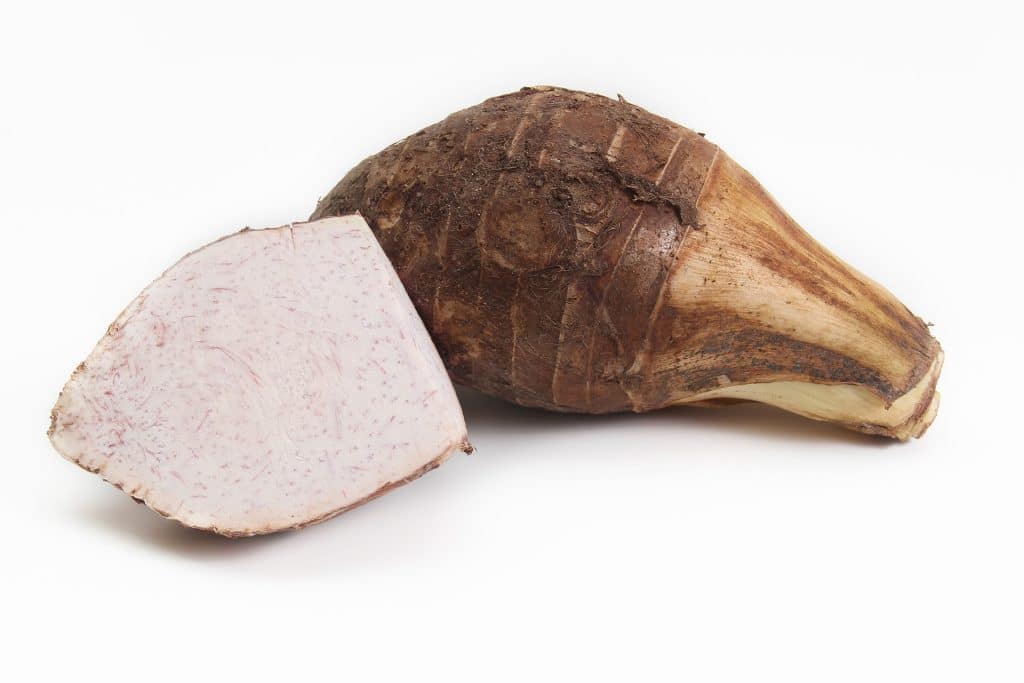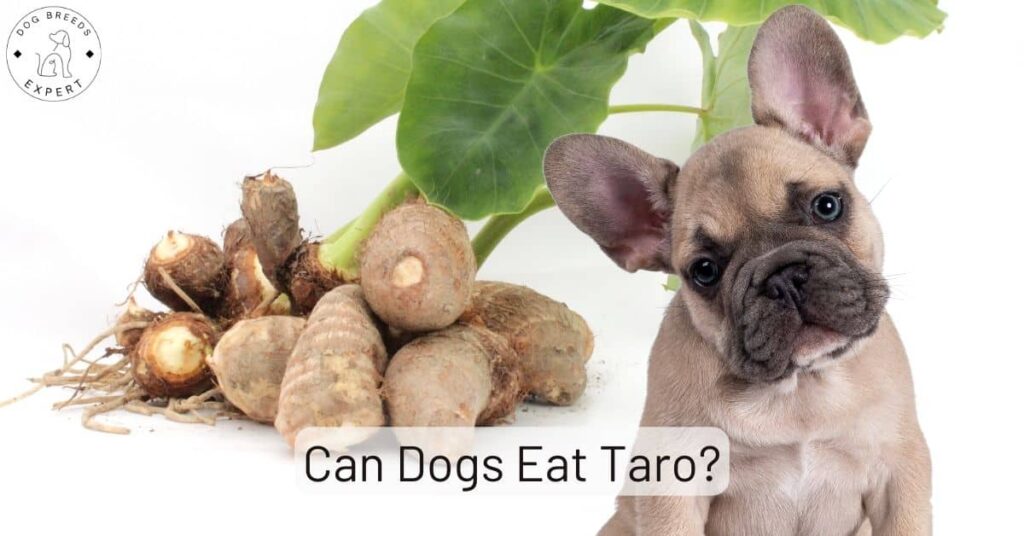Also known as dasheen or eddo, taro is a starchy root vegetable in the Araceae family. It is a tropical plant and is native to the Southeast Asian region of the globe. The plant produces edible roots with brown skin and white flesh flecked with purple. While it is commonly referred to as a root, it is technically a subterranean stem.
Taro Root

For humans, taro is delicious and nutritious. You can use it to make a wide range of foods like poi and pudding, or use it for flavoring in endless other dishes. But for your animals, taro is not good to eat at all. It’s easy to assume that if something is good for us, it will also be good for our pets. But this is not the case with taro.
As usual, our concern is whether or not dogs can eat taro. Unfortunately, the answer to that question is a hard No. Dogs should never eat taro, not ever, and not under any circumstances. The entire taro plant is toxic to dogs. The roots in particular are so toxic in fact that it is considered to be poison to dogs.
If your dog has eaten taro you should get him or her to the veterinarian as quickly as you possibly can. Taro is also highly toxic to cats.
Taro Plant Leaves

My Dog Ate Taro! What Should I Do?
The roots of the taro plant are poison to dogs. The rest of the plant is merely toxic. If your dog has eaten part of the taro plant other than the root, you can expect vomiting and diarrhea. If your dog has eaten the root of the taro plant, the situation is very serious and your dog’s life is in jeopardy.
What to Do if You Think Your Dog Has Eaten Taro
You don’t want to wait and see if your dog is going to have a bad reaction. The first thing you should do is determine whether or not he has actually eaten taro.
Verify the Incident
It is unlikely that your dog will have eaten a large amount of taro. Therefore, there should be remains of the plant near where you stored it, near your dog, or somewhere in between. Look for ripped-up packaging, messes, and other clues. If the taro was part of another prepared food that your dog might like, then he may have eaten all of the taro contents. If it was just a plain taro plant, you will probably find most of the taro you had stored.
In the unlikely scenario that your dog has eaten a whole portion of the plain taro plant, you should still find bits in and around his mouth. Finally, try to determine what part of the plant your dog has eaten. If it was the roots, be very concerned and be ready to act.
If your dog ate a part of the plant other than the root, (and he is not a tiny dog), he will probably be okay. Give him food and water. Wash out his mouth if you can, and keep a close eye on him. Expect vomiting and diarrhea.
Call Your Vet or Poison Control
If your dog is small and has eaten any taro or if he is large and ate a large amount, call poison control and your vet. If any dog has eaten any amount of taro root, call poison control and your vet.
Watch for Signs of Taro Poisoning
While you’re deciding to call, while you’re calling, and while you are waiting or transporting, you have another important job to do. Keep a close eye on your dog. Watch for signs of nausea, drooling, vomiting, weakness, irritated eyes, inflamed tissues in the mouth and throat, difficulty breathing, dehydration, and convulsing. If you can, have poison control or an animal helpline on the phone. They may be able to advise you on what to do based on what you see.
Take Action
If the signs and symptoms are severe, or if you know your dog has eaten the root of the taro plant, take him to your vet as soon as you can.
Preventing Taro Poisoning
We thought it would have been in poor taste to put this section in front of the “what to do” section, in case someone is in an emergency looking up this article. Hopefully, you have either gotten through your taro scare or just want to prevent one. In that case, this may still have value.
Clearly, there are foods humans can eat that dogs must never eat. Chocolate is no surprise, but an ordinarily nutritious root does seem to come out of left field.
Knowing what you know now, you should always keep taro stored securely up and away from your dog’s reach. Furthermore, any food that you don’t know is good for your dog should be treated as if it will hurt him. The same goes for cats.
Humans are more complex. We have adapted to a wider range of foods and environments than dogs. So it stands to reason that we would be able to eat things that they can’t.
Hopefully, this article found you at a time when it can serve as a warning, and not as a reaction to an emergency. Either way, we wish you and your pets well.
Photo Credits:
Taro Fruit (Pixabay)
Taro Plant (Pixabay)



